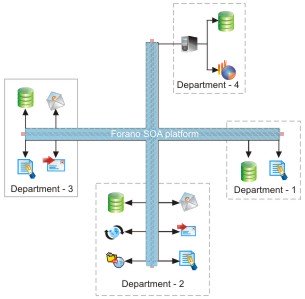Government and Defense – County of Tulare
 View as PDF
View as PDF
Tulare County Integrates Electronic Court Systems with Fiorano SOA Platform

Customer Profile
With a population of 397,000, Tulare County, California is one of the largest counties in the San Joaquin Valley and is the second-leading producer of agricultural commodities in the United States. The county is geographically situated about midway between San Francisco and Los Angeles, the two principal cities of the Pacific Slope. The Tulare County Justice Department consists of several county departments involved in the justice process such as Superior Court, DA, Probation, Public Defender, Sheriff and Agricultural Crimes.
Business Problem
The criminal justice system in Tulare County functions like most local criminal justice systems across the US, utilizing an intricate communication network consisting of Court, District Attorney, Probation, Public Defender and Sheriff departments. With advancements in justice system technology, Tulare County decided to redesign its IT infrastructure to eliminate inherent communication inefficiencies.
Communication and information sharing were tricky. Since the departments were separate from each other, each had developed its own system for storing data. Unfortunately, no bridge between the systems existed. Furthermore, because each business infrastructure had been developed independent of the others, most of the platforms were incompatible and unable to communicate without middleware.
IT project manager Alicia Beal, who was designated the task of finding a way to connect the systems, elaborates: "Implementing an integrated justice system is extremely difficult to say the least. The process involves systems that communicate differently; for instance, if you wanted to pass information about eye color, one system might call it "brown" while the other calls it "auburn". One of the biggest difficulties was finding a way to translate this information between systems."
Replacing the different systems would be a time-consuming and expensive process and would require the use of resources the Tulare County justice system did not have available. Instead, Beal decided to bridge the systems with a Real-Time architecture for information sharing.
Solution
Beal and the IT team evaluated basic factors for many Service Oriented Architecture (SOA) solutions and narrowed the choice down to fewer products. Following a stringent technical "proof of concept" to evaluate each solution's effectiveness, Tulare County eventually picked the Fiorano SOA Platform due to its ease-of-use, inherent design advantages and affordability.
"Fiorano SOA works well for government organizations because it is scalable across existing heterogeneous IT infrastructures and flexible for changing business processes quickly with little or no programming," remarked Beal.
As a result of the solution's scalability and flexibility, ongoing costs to maintain Fiorano SOA are significantly lower. Fiorano SOA's prebuilt adaptors are important to bridging and transforming processes without a need to fund risky, large scale rip-and-replace projects for application integration.
Tulare County's current architecture based on the Fiorano SOA framework functions in a two-step process. First, when an individual has to go to court, the District Attorney's office receives a packet of information regarding the case to help them determine whether they would like to prosecute or not. The DA then files the claim using its internal data architecture, including the necessary data and documents for the Court to review. That information is fed into the Fiorano system, which translates the data and bridges the DA and Court electronic systems. Second, the Court can accept or reject the claim and shoot it back to the DA. If the claim is rejected, emails are sent to everyone involved explaining why the claim was rejected.
Tulare County is in the process of introducing the Fiorano SOA Platform into other areas such as integrated scheduling and financial processing.
"As we get more and more familiar with Fiorano SOA, we'll begin using it for more applications," remarks Beal. "Eventually, we'll extend the solution beyond the justice system and into other Tulare County departments."

FIGURE 1 : Integration of various justice departments using Fiorano SOA Platform
Benefits
"When it comes to initiating a case in the court system, we've eliminated double entries that would often occur from simple oversight," says Beal. "Accuracy as a whole has improved. We've eliminated the potential for human error because the information is passed electronically, rather than being keyed into two separate systems by different people."
Because data, documents and other relevant information is passed electronically, Tulare County has saved countless hours that would have applied to the physical process of passing papers back and forth. With electronic data transmission, Tulare County is also saving money on paper and ink that would have been used to record the tremendous amounts of data constantly passing through the justice system.
For the DA's office, the implementation of Fiorano SOA has been especially useful. The solution allows the DA to see Court decisions in Real-Time, thus greatly reducing the time it used to take for them to receive this information.
Beal concludes, "With Fiorano SOA, we are one of only a few counties in the entire state of California to integrate our electronic data system and IT infrastructure. Fiorano SOA has kept us on the cutting-edge of enterprise technology, positioning our justice system as one of the more technologically progressive and forward-thinking. These changes have not only made our lives easier and our jobs more efficient; they have made Tulare County's residents' lives easier as well."
About Fiorano Software
Fiorano Software (www.fiorano.com) is a leading provider of enterprise class business process integration and messaging infrastructure technology. Fiorano's network-centric solutions set a new paradigm in ROI, performance, interoperability and scalability. Global leaders including Fortune 500 companies such as Boeing, British Telecom, Credit Agricole Titres, Lockheed Martin, NASA, POSCO, Qwest Communications, Schlumberger and Vodafone among others have used Fiorano technology to deploy their enterprise nervous systems.
To find out more about how Fiorano can help you meet your enterprise integration objectives, visit www.fiorano.com or Email us, we will contact you!

 World Wide Support
World Wide Support